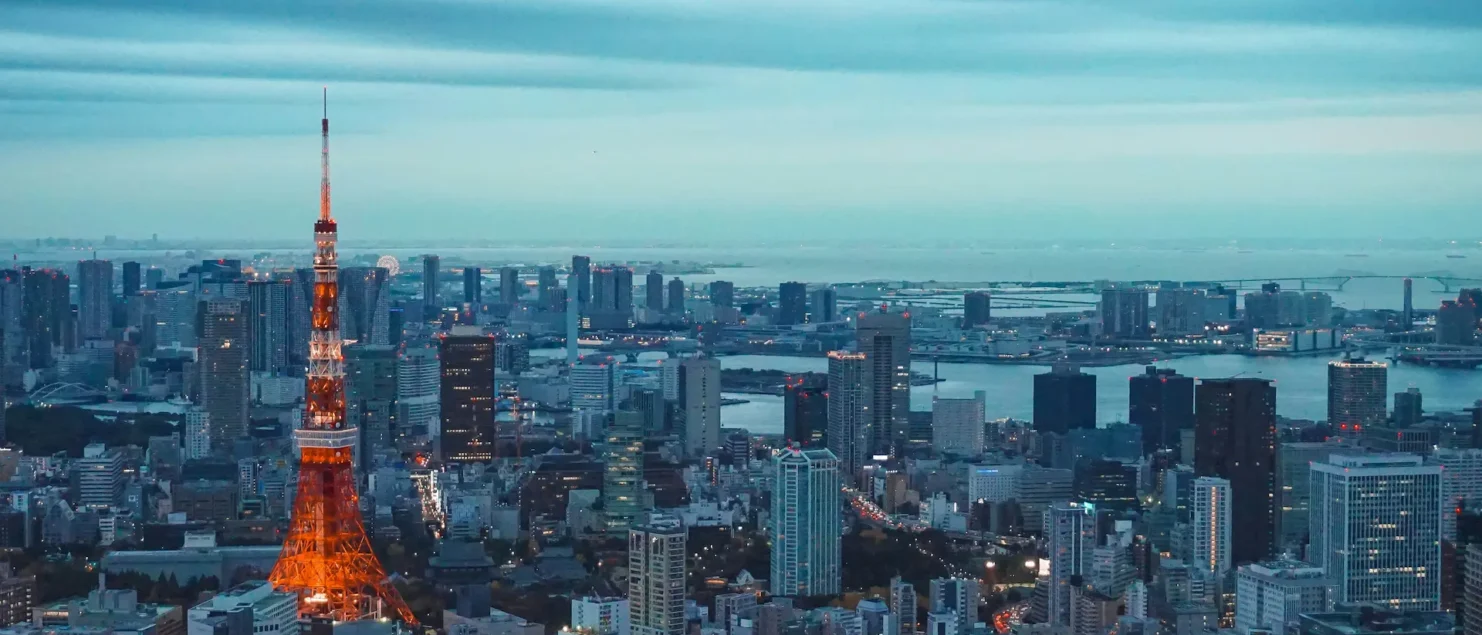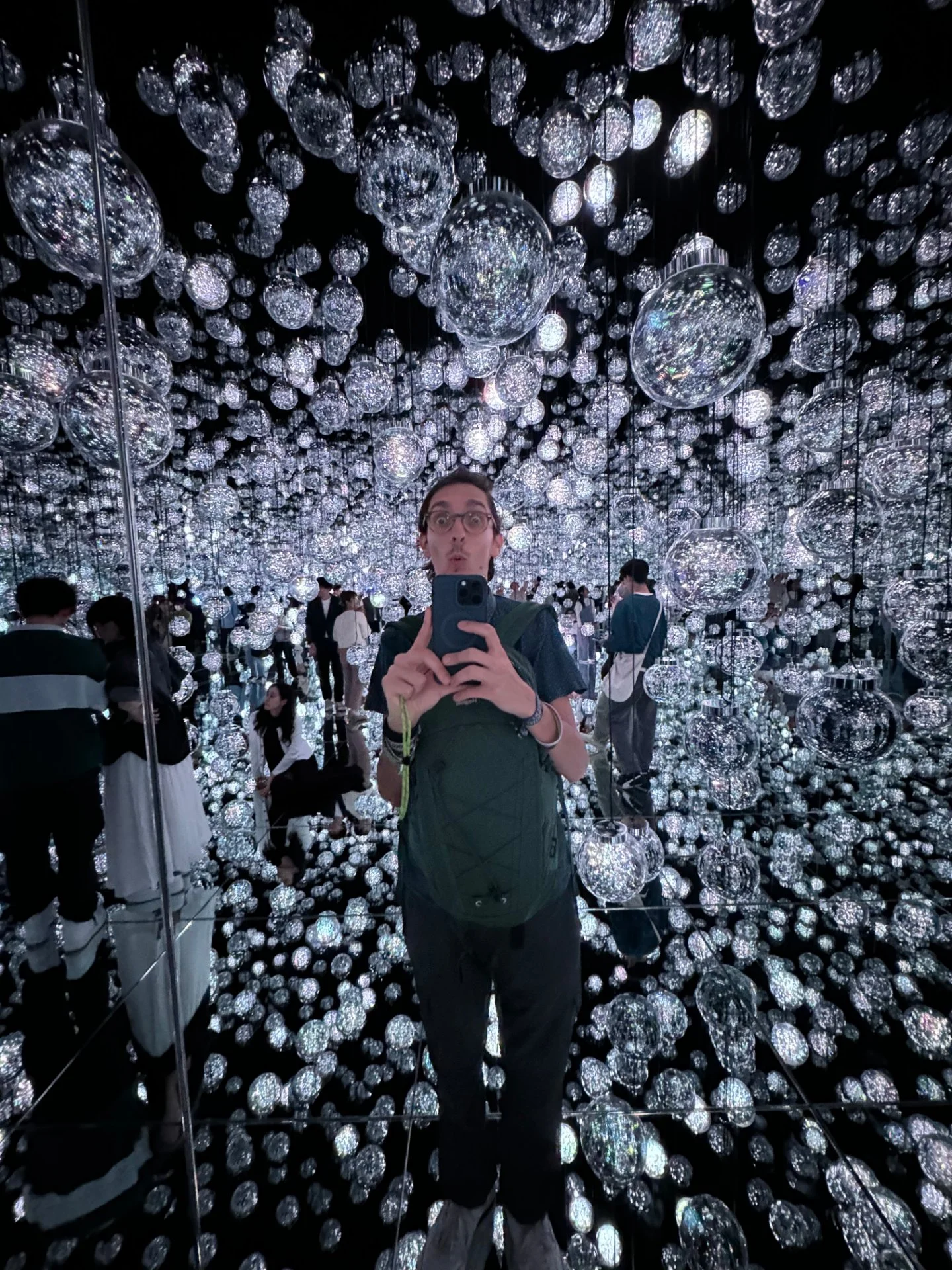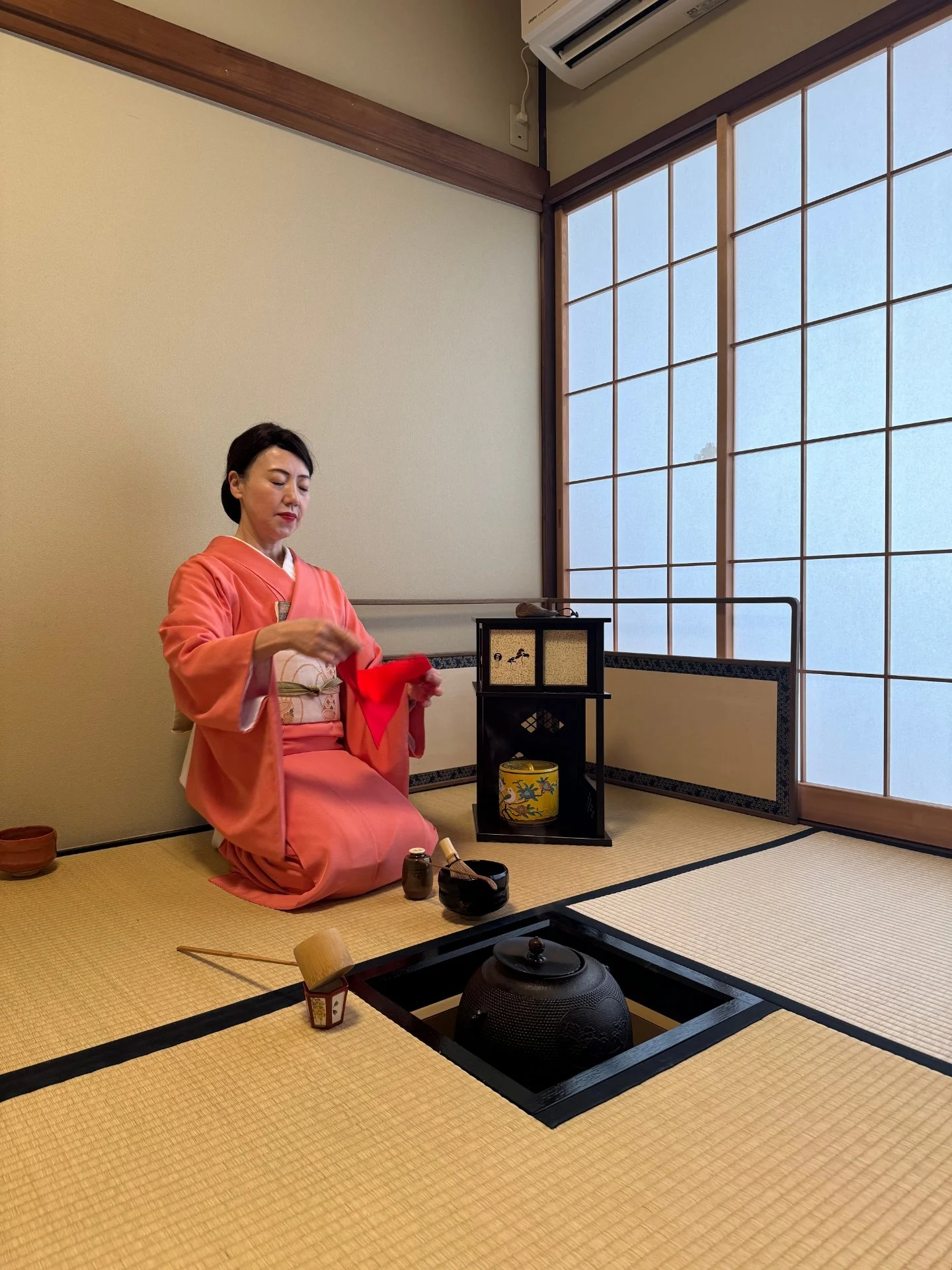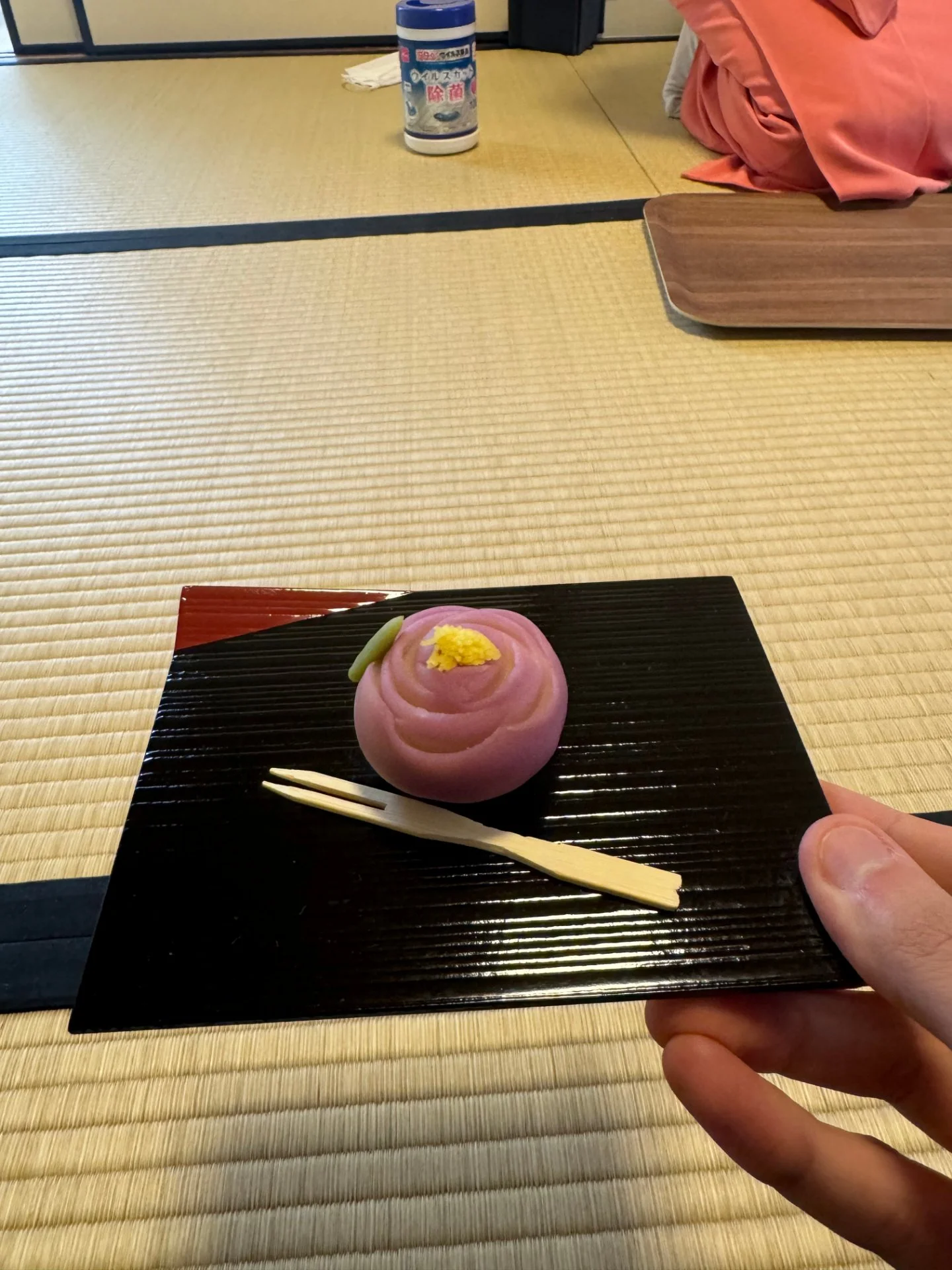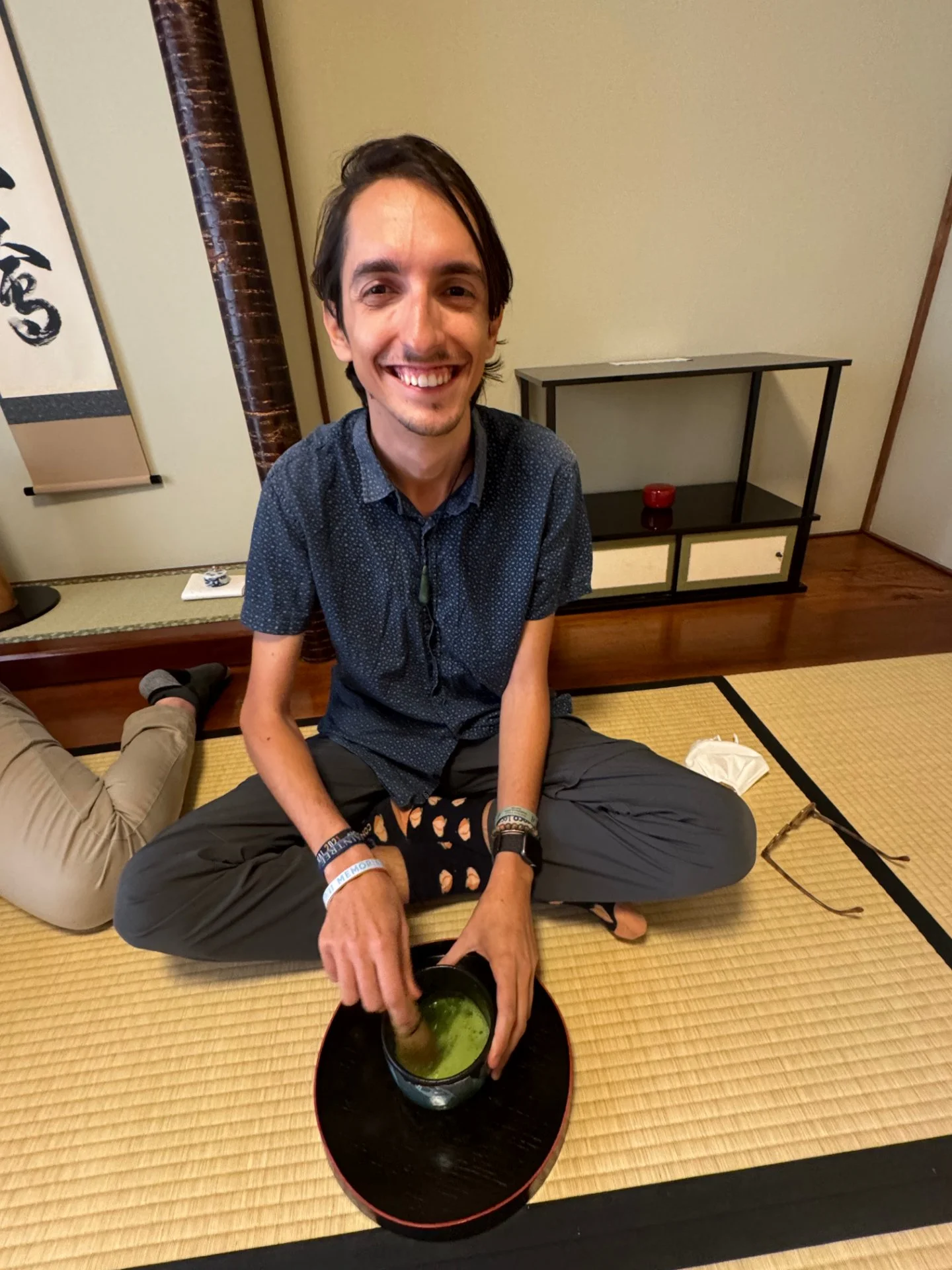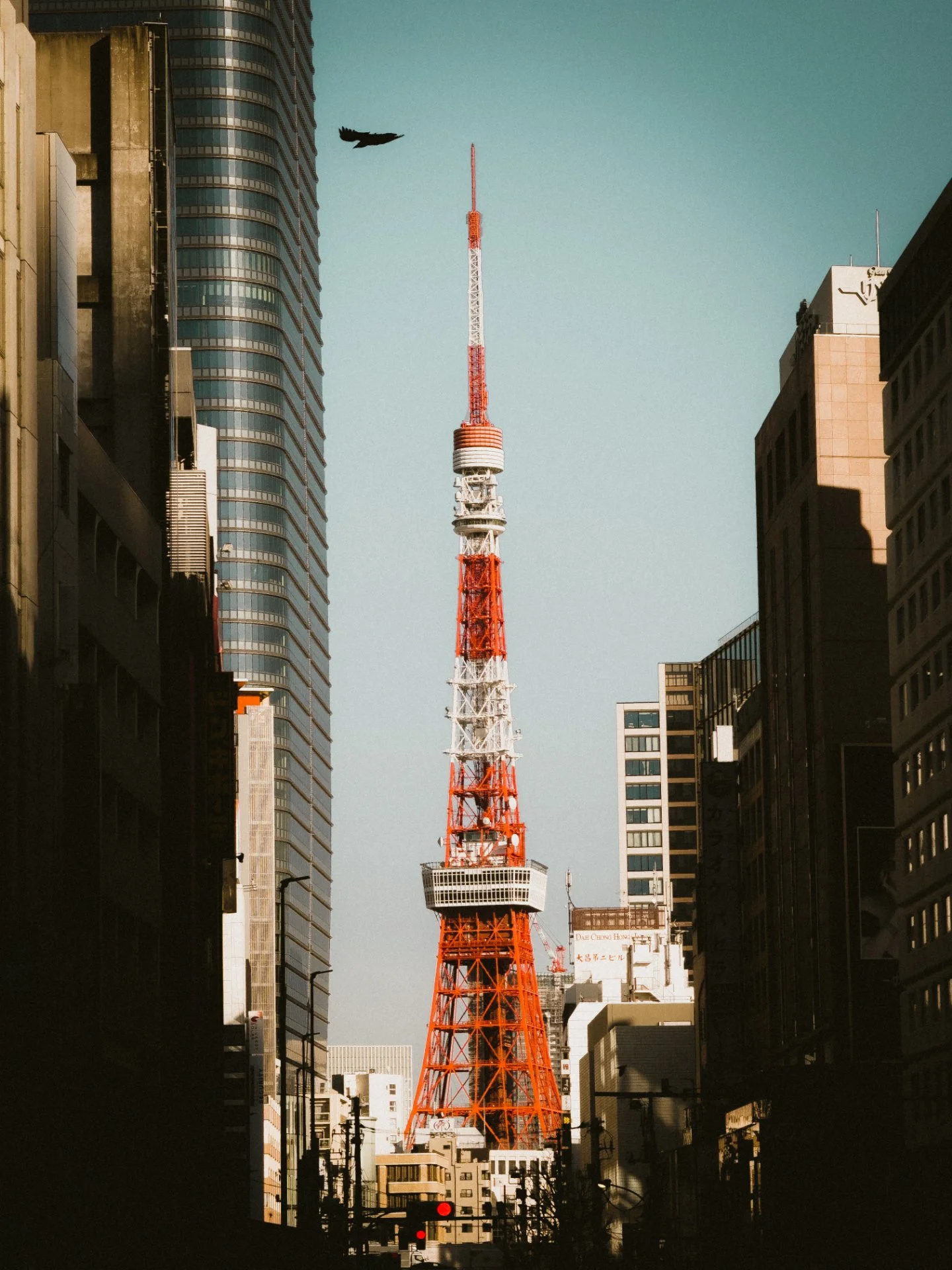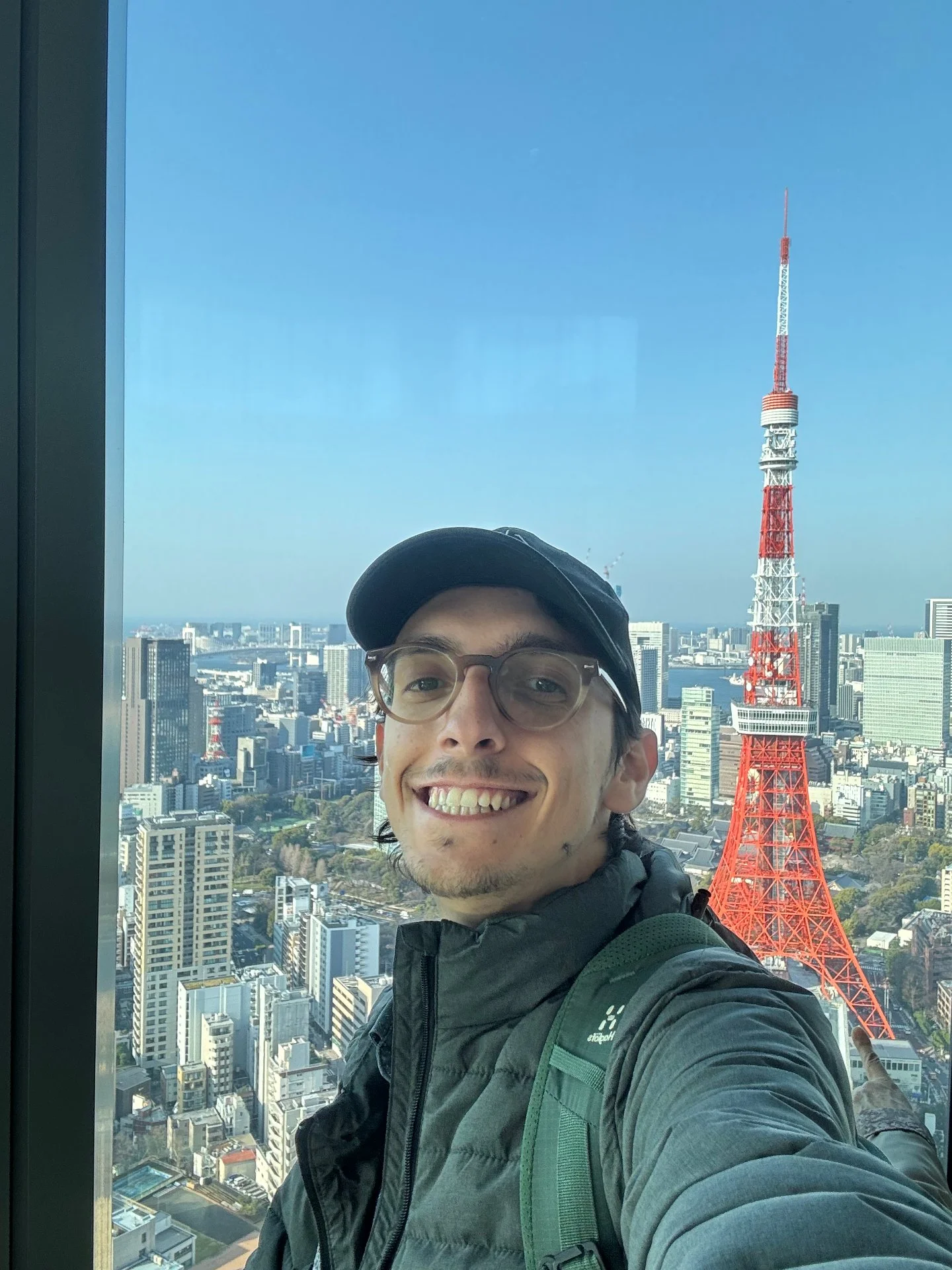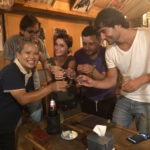Tokyo Travel Guide: A Dream Destination for First-Time Visitors
Last updated: May 2025
After years of dreaming about visiting Japan, last year I finally managed to visit it and it did not disappoint at all! Especially Tokyo, which was everything I had hoped for and more! As the most populous city in the world, Tokyo offers an incredible contrast of bustling energy and surprising pockets of tranquility. For an anime and manga enthusiast like me, this trip was absolute heaven (the One Piece store nearly emptied my wallet!).
In this comprehensive guide, I’ll share my Tokyo experience—where to stay, what to eat (even as a vegetarian), must-see attractions, and practical tips to make your trip as smooth as mine was. Tokyo’s remarkable cleanliness, efficiency, and endless variety make it unlike any city I’ve ever visited!
When to Visit Tokyo
I visited Tokyo from late February through mid-March, which turned out to be a good choice. To be honest, though, I hadn’t really planned to visit it around that time. In January I was in Vietnam and, as usual, my plan was to stay in South East Asia for a few months so I only had summer clothes with me. Then, in a whim, I decided to go to South Korea and Japan. In Seoul the temperatures got to -5C while, by the time I got to Tokyo, the weather wasn’t too cold, hovering between 7-15°C, although it did get quite windy on some days. I still had to use the only jacket and warm clothes I had which I had bought on my last day in Hanoi but it was doable! If you visit during this time, pack layers and a good windbreaker.
This period sits nicely between winter and the famous cherry blossom season (typically late March to early April). While I just missed the full on sakura blooms (some trees were already pink and fluffy), I benefited from smaller crowds and better accommodation prices.
Best times to visit Tokyo:
- Late February to early March (pre-cherry blossom season) – fewer tourists, cooler temperatures
- Late March to early April (cherry blossom season) – beautiful but extremely crowded
- October to November (autumn) – comfortable temperatures, beautiful fall colors
- May (late spring) – pleasant weather after the cherry blossom crowds leave
How to get to Tokyo
International Flights
Most international flights arrive at either Narita International Airport (NRT) or Haneda Airport (HND). Haneda is closer to central Tokyo (about 30 minutes by train), while Narita is farther (60-90 minutes). I started my Japan trip in Osaka and then made my way to Tokyo via Mt Fuji. I had booked a bus which ended up being pretty comfortable and much cheaper than the Shinkansen!
From the Airport to City Center
From Narita Airport:
- Narita Express (N’EX): The most convenient option, taking about 60 minutes to Tokyo Station. Cost: approximately ¥5000 one-way.
- Keisei Skyliner: Another express train option, reaching Ueno Station in about 40 minutes. Cost: around ¥2,580 one-way.
- Airport Limousine Bus: Direct service to major hotels and stations. Takes 75-120 minutes depending on traffic.
From Haneda Airport:
- Tokyo Monorail: Connects to Hamamatsucho Station in about 15 minutes. Cost: about ¥500.
- Keikyu Line: Reaches Shinagawa Station in about 15 minutes. Cost: about ¥410.
- Airport Limousine Bus: Direct service to major areas. Takes 30-45 minutes.
Where to Stay in Tokyo
Tokyo is massive, with each neighborhood offering a distinct vibe. During my trip, I stayed exclusively in Asakusa and found it to be an excellent base—centrally located with good transportation links to all major areas.
My Accommodation Experiences
Sakura Hostel Asakusa
Price range: ¥3,500-4,500 per night (dorm room)
My experience: This hostel was definitely affordable and in a prime location, just minutes from Sensoji Temple. However, it was extremely busy, and my room wasn’t the cleanest. The common areas were lively—great for meeting other travelers and some breakfast was included, but not ideal if you’re seeking peace and quiet. The staff were helpful but often overwhelmed by the number of guests.
Tokyo W Inn Asakusa
Price range: ¥4,000-6,000 per night (dorm room)
My experience: After a few nights at Sakura Hostel, I switched to Tokyo W Inn and was much happier with my choice. Though slightly more expensive, the cleanliness, comfort, and quieter atmosphere were worth every yen. The rooms, while compact (as is standard in Tokyo), were thoughtfully designed with all essential amenities and the view from the rooftop was truly beautiful!
Other Recommended Neighborhoods for Accommodation
Shinjuku: Perfect for nightlife enthusiasts and shoppers
- Pros: Central location, excellent transportation hub, endless entertainment and dining options
- Cons: Can be overwhelming and noisy, especially for first-timers
Shibuya: Ideal for younger travelers and those seeking the “classic Tokyo” experience
- Pros: Famous crossing, trendy shops, vibrant atmosphere
- Cons: Crowded, can be expensive
Tokyo Station/Marunouchi: Great for business travelers or those planning day trips
- Pros: Convenient for train travel, upscale accommodations
- Cons: Business district atmosphere, quieter at night
Ueno: Good budget-friendly option with cultural attractions
- Pros: Lovely park, museums, more affordable accommodations
- Cons: Slightly older area, fewer nightlife options
Why I Recommend Asakusa
As a first-time visitor to Tokyo, I found Asakusa to be the perfect home base. It offers:
- A more traditional Japanese atmosphere
- Excellent subway connections (multiple lines) that made getting anywhere in Tokyo easy
- Walking distance to major attractions like Sensoji Temple and Tokyo Skytree
- More affordable accommodation and dining options
- A slightly slower pace compared to Shinjuku or Shibuya, making it less overwhelming
Getting Around Tokyo
Tokyo’s public transportation system is nothing short of amazing—efficient, clean, and incredibly punctual. Here’s what worked for me:
Suica Card
I used a digital Suica card on my iPhone, which was incredibly convenient—no need to carry a physical card! You can add this to your Apple Wallet and simply tap your phone at station gates. For Android users, there’s a similar option called PASMO.
To set up digital Suica:
- Open Apple Wallet
- Tap the + sign
- Select “Transit Card”
- Follow the setup instructions
- Add money using your credit card
You can also purchase a physical Suica card at any major station for a ¥500 deposit, plus whatever amount you want to charge. However, it can sometimes be hard to find a physical card which is why I recommend the digital one.
Tokyo Metro and JR Lines
The subway and train systems are extensive and can get you virtually anywhere in the city. Major lines to know:
- JR Yamanote Line: A loop line connecting most major districts
- Tokyo Metro: The subway system with multiple lines covering the entire city
- Toei Subway: Another subway network that complements the Tokyo Metro
Tips for Tokyo Transit:
- Trains stop running around midnight, so plan accordingly
- Rush hour (7:30-9:00 AM and 5:30-7:00 PM) can be extremely crowded
- Google Maps works exceptionally well for transit directions in Tokyo
- Always stand on the left side of escalators (except in Osaka, where it’s the opposite)
- The trains are incredibly punctual—if it says 7:42, it will arrive or depart at 7:42!
Must-Visit Neighborhoods
Each Tokyo neighborhood has its own distinct personality. Here are the areas I found most captivating:
Asakusa
Where I stayed and a wonderful glimpse into old Tokyo. Don’t miss:
- Sensoji Temple: Tokyo’s oldest temple with the famous Kaminarimon Gate
- Nakamise Shopping Street: Perfect for traditional souvenirs
- Tokyo Skytree: Just a short walk across the Sumida River
Shibuya
The epitome of modern Tokyo:
- Shibuya Crossing: The world’s busiest pedestrian crossing
- Hachiko Statue: The famous loyal dog’s meeting point
- Center Gai: Bustling shopping street popular with younger crowds
- Shibuya Sky: Amazing panoramic views of Tokyo
Shinjuku
Urban energy and nightlife central:
- Shinjuku Gyoen: Beautiful park offering respite from the chaos
- Golden Gai: Tiny alleyways filled with over 200 miniature bars
- Tokyo Metropolitan Government Building: Free observation decks
- Kabukicho: The famous (but touristy) entertainment district
Harajuku
Japan’s fashion hub:
- Takeshita Street: Teen fashion paradise and crepe stands
- Omotesando: Tokyo’s Champs-Élysées with high-end boutiques
- Meiji Shrine: Serene forest shrine in the heart of the city
Akihabara
Geek paradise (and my personal favorite as an anime fan):
- Electronics shops: Multi-story buildings selling every gadget imaginable
- Anime and manga stores: Heaven for collectors
- Maid cafés: Unique themed restaurants
- Gachapon alleys: For collectible capsule toys
Ginza
Tokyo’s upscale shopping district:
- Department stores: Mitsukoshi, Matsuya, and more
- Tokyo International Forum: Architectural marvel
- Kabuki-za: Traditional kabuki theater
Top Attractions and Experiences
My Absolute Favorites
TeamLab Borderless
This digital art museum was UNBELIEVABLE! Words can’t describe the immersive, interactive installations that completely transform your sense of space and reality. I spent nearly four hours here and could have stayed longer.
Tips for TeamLab:
- Book tickets well in advance online
- Go early in the day to avoid crowds
- Wear comfortable shoes and clothes you can move in
- Download their app before visiting for enhanced experiences
Capybara Café

One of my most heartwarming experiences in Tokyo was visiting a capybara café. These gentle giants are the world’s largest rodents and are incredibly sweet-natured. I simply showed up before opening time to secure a spot, but it can get busy, so consider booking ahead during peak tourist seasons.
The experience includes:
- Supervised interaction time with capybaras and you can feed them
- Photo opportunities
- Learning about their care and behavior
- A drink included in your entry fee
Owl Café
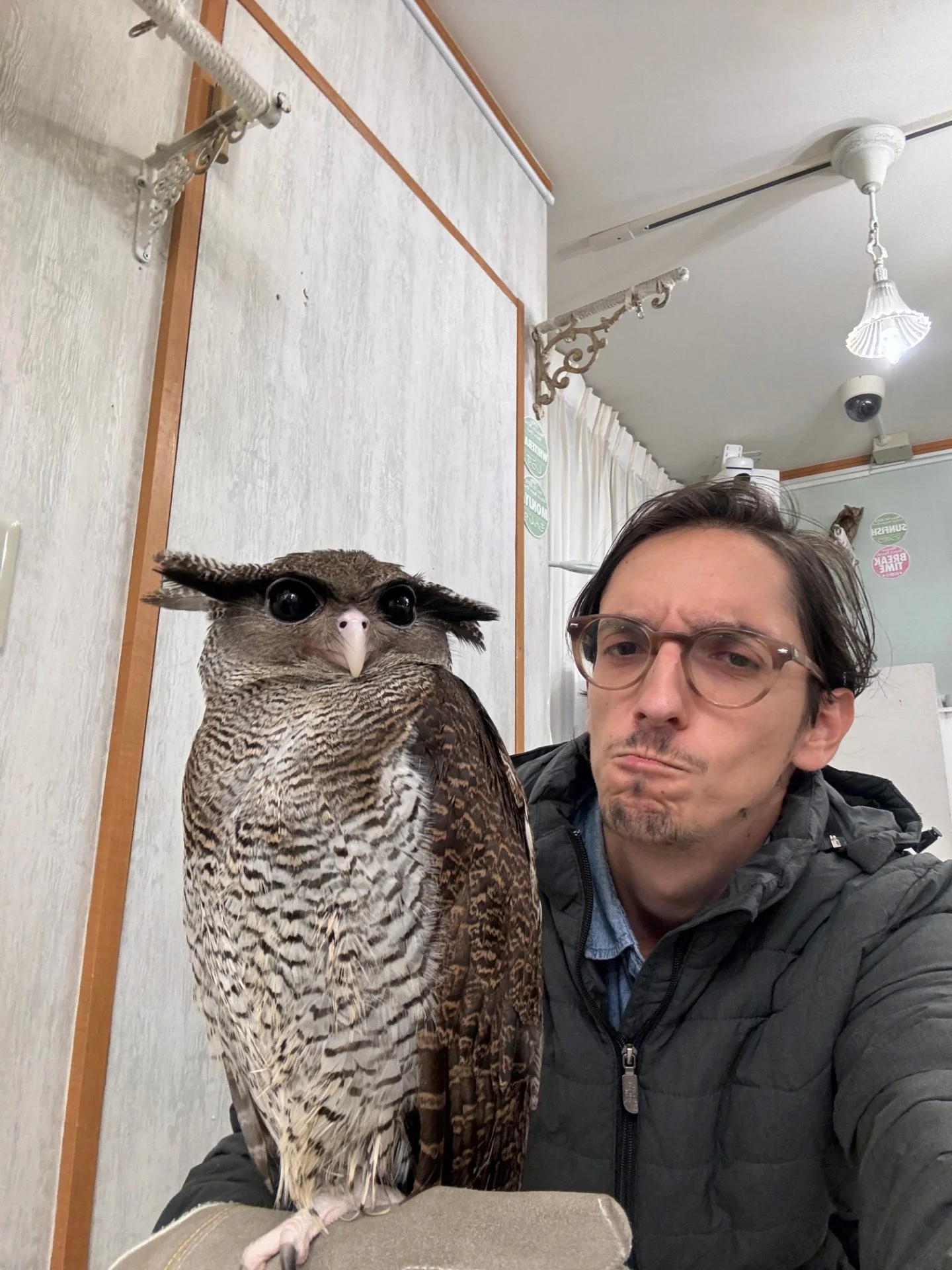
Another animal encounter I enjoyed was an owl café, which I booked online the day before visiting. These magnificent birds are fascinating up close and I couldn’t stop gazing into their big eyes.
Japanese Bathhouse (Sento)
Visiting a traditional bathhouse was initially outside my comfort zone but ended up being one of my most authentic Japanese experiences. If you have tattoos like me, make sure to research tattoo-friendly establishments beforehand, as many traditional bath houses still prohibit them.
Bathhouse etiquette:
- Shower thoroughly before entering the bath
- Leave your modesty at the door (bathing is nude, usually gender-separated)
- Bring a small towel for privacy while walking around although it’s usually provided
- Stay quiet and respectful
- Don’t put your towel in the bath water
Tea Ceremony at Shizu Kokoro Chado School
This was a highlight of my cultural experiences in Tokyo. Ms. Mika, the instructor, was extremely knowledgeable about every aspect of the ceremony. The class was small and intimate with perfect energy and attention to detail. I learned about the philosophy behind each movement and the deeper meanings of this ancient ritual. Although I’m not a fan of matcha tea, I found the one prepared by Ms. Mika to be fragrant and delicious.
What to expect:
- Detailed explanation of tea ceremony history and significance
- Demonstration of proper sitting posture and movements
- Opportunity to make and serve matcha tea yourself
- Sampling of traditional Japanese sweets
- A deep appreciation for Japanese attention to detail
Other Must-See Tokyo Attractions
- Tokyo Imperial Palace: The primary residence of Japan’s Emperor
- Tokyo Tower: Iconic red and white tower inspired by the Eiffel Tower. If you want to get an insane view of it and of the city for free, stop by the Metropolitan Government Building in Shinjuku. Follow the signs and you will end up on the 45th floor surrounded by this incredible city!
- Ueno Park: Beautiful park with multiple museums and a zoo
- Tsukiji Outer Market: Amazing food stalls and restaurants (the inner market relocated to Toyosu)
- Yoyogi Park: Spacious park popular for picnics and people-watching
- Robot Restaurant: Over-the-top entertainment (touristy but fun)
- Ghibli Museum: A must for Studio Ghibli fans
Food Guide for Tokyo
Tokyo is a food lover’s paradise, with more Michelin-starred restaurants than any other city in the world. However, as a vegetarian, I initially struggled to find suitable options—Japanese cuisine traditionally incorporates fish stock (dashi) in many seemingly vegetarian dishes.
Vegetarian-Friendly Places I Discovered
CoCo Ichibanya (CoCo Curry House)
This curry chain saved me multiple times during my trip! They offer a vegetarian menu with delicious Japanese curry served over rice. You can customize your spice level and add various vegetable toppings. Affordable and satisfying!
T’s TanTan (Tokyo Station)
A completely vegan ramen shop inside Tokyo Station. Their tantanmen ramen is incredibly flavorful, and you won’t miss the meat at all.
Ain Soph Journey (Shinjuku)
Upscale vegan restaurant with beautiful presentations. Their vegan “egg” sandwich is mind-blowing.
Saishoku Vegetarian (Multiple Locations)
Traditional Buddhist vegetarian cuisine (shojin ryori) in a modern setting.
Must-Try Food Experiences (Including Non-Vegetarian Options)
- Conveyor Belt Sushi: Fun, affordable sushi experience
- Ramen: Try different regional styles at shops throughout the city
- Yakitori: Grilled skewers, many places offer vegetable options
- Tempura: Lightly battered and fried vegetables or seafood
- Okonomiyaki: Savory pancakes with various fillings
- Department Store Food Halls: Amazing variety of ready-to-eat foods
- Convenience Store Food: Don’t laugh—Japanese convenience stores have surprisingly good quality meals! I’ve had some very tasty pasta from 7/11 a few times! (I know, I was in Japan but also craving pasta!)
Dining Tips
- Learn the phrase “Watashi wa bejitarian desu” (I am vegetarian)
- Consider bringing cards explaining your dietary restrictions in Japanese
- Use the Happy Cow app to find vegetarian and vegan-friendly restaurants
- Be aware that many restaurants display realistic plastic food models outside—these are incredibly helpful for pointing to what you want!
Shopping in Tokyo
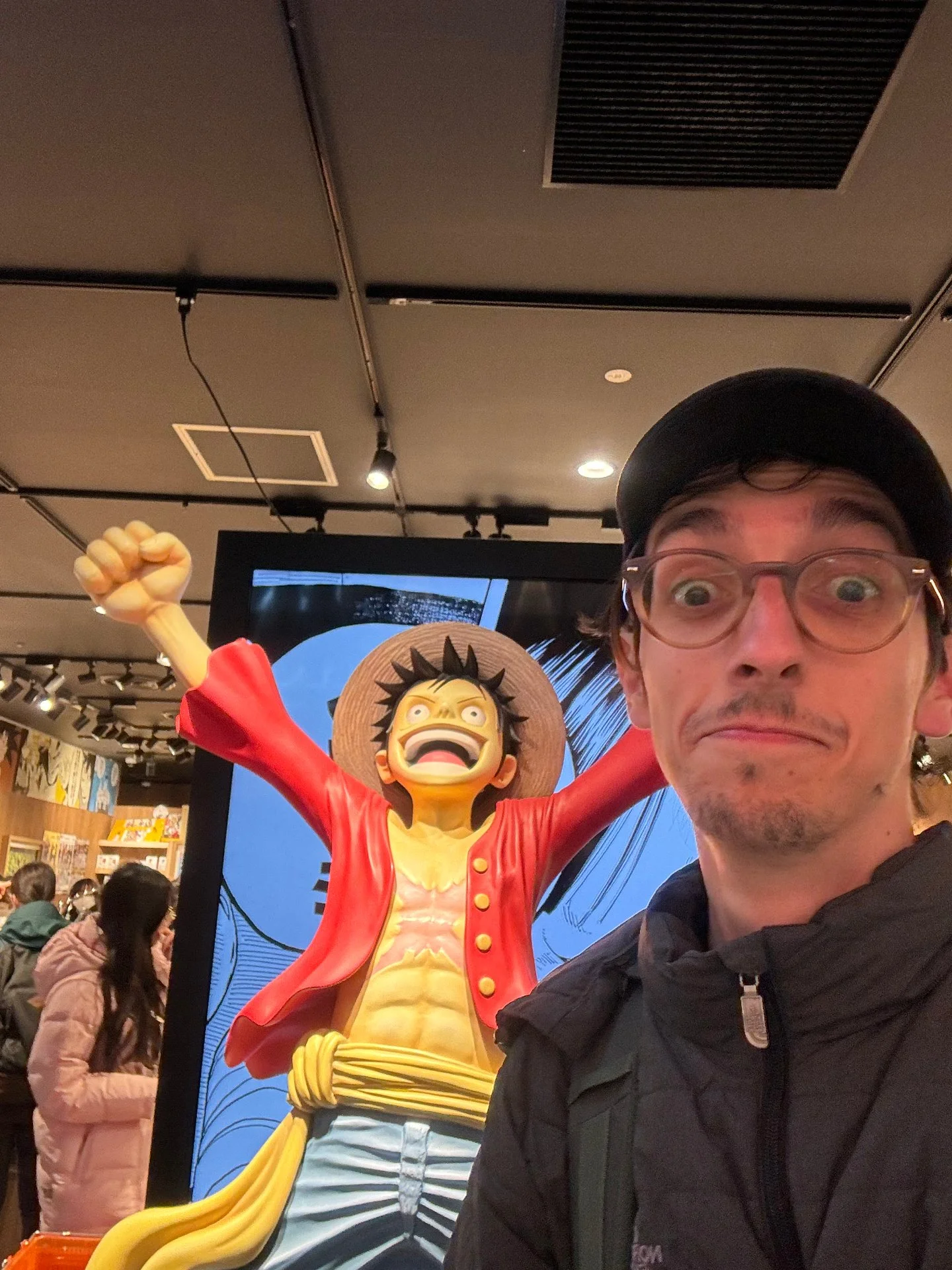
As an anime fan, shopping in Tokyo was dangerously tempting for my wallet! Here are my favorite shopping experiences:
Anime and Manga Paradise
The One Piece Store (Shibuya)
I nearly went broke here! Located in Shibuya, this store is heaven for One Piece fans with exclusive merchandise you can’t find outside Japan. The life-sized character figures make for great photo ops too!
Nakano Broadway
Less touristy than Akihabara but equally amazing for anime fans. This multi-level shopping mall is filled with stores selling everything from current merchandise to rare vintage collectibles.
Mandarake (Multiple Locations)
The ultimate second-hand anime and manga store. Their Shibuya location specializes in dōjinshi (fan-created manga), while the Akihabara branch has more figures and toys.
Other Shopping Destinations
- Don Quijote (“Donki”): Multi-level discount stores selling EVERYTHING
- Tokyu Hands: Incredible variety of crafts, household items, and unique gifts
- Daiso: Famous 100-yen shop (most items cost around $1)
- Uniqlo: Iconic Japanese casual fashion at good prices
- Kiddy Land: Multi-story toy store in Harajuku
- Character Street (Tokyo Station): Official stores for Pokémon, Hello Kitty, and other Japanese characters
- Yodobashi Camera Akiba: The biggest electronic store in Tokyo and definitely among the biggest ones in the world! It’s 6 floors absolutely filled with any electronic gadget you could think of!
Shopping Tips
- Bring your passport when shopping—many larger stores offer tax-free shopping for tourists (minimum purchase amounts apply)
- Most places accept credit cards, but having cash is still useful for smaller shops. I suggest you get some cash out of the ATMs inside 7/11 as they tend to have the lowest fees.
- Don’t be afraid to ask for gift wrapping—Japanese stores excel at beautiful packaging
- Consider bringing an extra suitcase or shipping items home directly from the post office
Cultural Experiences
Beyond the typical sightseeing, these cultural experiences gave me deeper insights into Japanese traditions:
Everyday Cultural Experiences
Convenience Stores
Don’t laugh, but exploring Japanese convenience stores (konbini) is a cultural experience in itself! From oden in winter to perfectly wrapped onigiri rice balls, the food quality (and the gadgets) are impressive.
Public Parks

I loved observing elderly groups practicing tai chi and the meticulous care taken in maintaining public spaces. Stop by the Ueno Zoological Gardens (admission is free on March 20th, May 4th, and October 1st, I went on the March 20th) if you want to admire the beautiful pandas! It was my first time seeing them in real life and they were soooo adorable!
100-Yen Shops
These stores (similar to dollar stores but with much higher quality) offer fascinating insights into daily Japanese life and make great places to pick up affordable souvenirs.
Day Trips from Tokyo
While Tokyo itself has endless things to explore, you could also fit in some wonderful day trips like:
Kamakura
Just an hour from Tokyo by train, this coastal town features:
- The Great Buddha (Daibutsu)
- Numerous ancient temples
- Hiking trails connecting spiritual sites
- A more relaxed atmosphere than Tokyo
Hakone
Famous for hot springs and Mount Fuji views:
- Hakone Round Course (combination of trains, cable cars, ropeway, and boats)
- Open-air museum with impressive sculptures
- Lake Ashi with iconic “pirate ships”
- Traditional ryokan (if you stay overnight)
You could also squeeze in a day trip to visit Mount Fuji but I recommend staying there at least one night! I stayed at Hostel Fuji Matsuyama Base in Fujiyoshida and loved it! It was a small, cozy and warm house where I met some truly beautiful people and you had a prime view of the mountain right outside the door!
Other Popular Day Trip Options
- Nikko: Elaborate shrines and natural beauty
- Yokohama: Japan’s second-largest city with a vibrant Chinatown
- Tokyo DisneySea: Unique Disney park not found elsewhere
- Mount Takao: Hiking and natural beauty close to the city
Practical Tips for Tokyo
Safety
Tokyo is incredibly safe—I felt comfortable walking alone even late at night. That said, common sense precautions still apply:
- Keep valuables secure
- Be aware of your surroundings
- Don’t leave belongings unattended
I’ve also heard that female travelers might experience some form of harassment. I can’t speak directly about it but it’s something to be aware of.
Money Matters
- Japan is still quite cash-dependent, though major establishments accept cards
- 7-Eleven ATMs reliably work with foreign cards
- Inform your bank of your travel plans before departure
- The current exchange rate makes Japan more affordable than its reputation suggests
Language
While many signs in Tokyo are in English, especially around tourist areas and train stations, learning a few basic phrases goes a long way:
- Arigatou gozaimasu (Thank you very much)
- Sumimasen (Excuse me/Sorry)
- Eigo ga hanasemasu ka? (Do you speak English?)
- Kore o kudasai (This one, please) – useful with pointing!
Etiquette Tips
- Remove shoes when indicated (traditional restaurants, some accommodations)
- Don’t tip (it’s not customary and can cause confusion) and always place your money on the little tray in front of the cashier
- Stand on the left side of escalators (to allow people to pass on the right)
- Be quiet on public transportation
- Don’t eat or drink while walking (find a place to sit)
Internet Access
Wi-Fi is very easy to find and it was always reliable and fast! Personally, I had bought an e-SIM from Agoda and never had any problems with it. I always try to get one when traveling, especially for a short amount of time, and I always check Agoda or Klook first before using any other service.
What to Pack
- Comfortable walking shoes (you’ll walk A LOT)
- Portable charger/power bank
- Hand sanitizer (many public restrooms don’t have soap)
- Light layers (for variable temperatures)
- Umbrella (sudden rain showers are common)
Budget Breakdown
Tokyo wasn’t as expensive as I’d feared, partly due to the favorable exchange rate during my visit. Here’s a rough breakdown of my expenses:
- Accommodation: ¥4,000-8,000 per night (≈AUD 42-85)
- Food: ¥600-3,000 per day (≈AUD 6-30), depending on where I ate
- Transportation: ¥300-1,000 per day (≈AUD 3-10)
- Shopping: This is where my budget suffered! Budget according to your self-control 😅
Money-saving tips:
- Eat lunch at restaurants rather than dinner (lunch specials are common)
- Stay in hostels or budget hotels
- Look for combination tickets for attractions
- Try standing sushi restaurants for more affordable sushi
Final Thoughts
Tokyo exceeded all my expectations. Despite being the world’s most populous city, it never felt overwhelming thanks to the incredible organization, cleanliness, and surprising pockets of tranquility. The contrast between ancient traditions and cutting-edge technology creates a magical atmosphere unlike anywhere else I’ve visited.
For anime and manga fans like me, Tokyo is the ultimate pilgrimage—but even if you’re not into Japanese pop culture, the city offers endless discoveries. From the efficiency of its transportation system to the meticulous attention to detail in everything, Tokyo will definitely leave a mark on you.
While a little over a week gave me a good introduction to this fascinating city, I feel like I’ve only scratched the surface. I’m hoping to get back there soon to explore more neighborhoods and experience the changing seasons in this remarkable metropolis.
Have you been to Tokyo or are you planning a trip? I’d love to hear your experiences or answer any questions in the comments below! What aspect of Tokyo are you most excited to experience?
This post contains my personal experiences and recommendations from traveling to Tokyo in early 2025. Prices and information are subject to change. This post may contain affiliate links, which means I may earn a small commission if you book through my links, at no extra cost to you. Thank you for supporting my blog!

